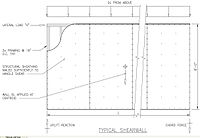
Photo from wikipedia
A novel method is developed for characterizing the mechanical response and failure mechanism of brittle rocks under dynamic compression-shear loading: an inclined cylinder specimen using a modified split Hopkinson pressure… Click to show full abstract
A novel method is developed for characterizing the mechanical response and failure mechanism of brittle rocks under dynamic compression-shear loading: an inclined cylinder specimen using a modified split Hopkinson pressure bar (SHPB) system. With the specimen axis inclining to the loading direction of SHPB, a shear component can be introduced into the specimen. Both static and dynamic experiments are conducted on sandstone specimens. Given carefully pulse shaping, the dynamic equilibrium of the inclined specimens can be satisfied, and thus the quasi-static data reduction is employed. The normal and shear stress–strain relationships of specimens are subsequently established. The progressive failure process of the specimen illustrated via high-speed photographs manifests a mixed failure mode accommodating both the shear-dominated failure and the localized tensile damage. The elastic and shear moduli exhibit certain loading-path dependence under quasi-static loading but loading-path insensitivity under high loading rates. Loading rate dependence is evidently demonstrated through the failure characteristics involving fragmentation, compression and shear strength and failure surfaces based on Drucker–Prager criterion. Our proposed method is convenient and reliable to study the dynamic response and failure mechanism of rocks under combined compression-shear loading.
Journal Title: Rock Mechanics and Rock Engineering
Year Published: 2017
Link to full text (if available)
Share on Social Media: Sign Up to like & get
recommendations!